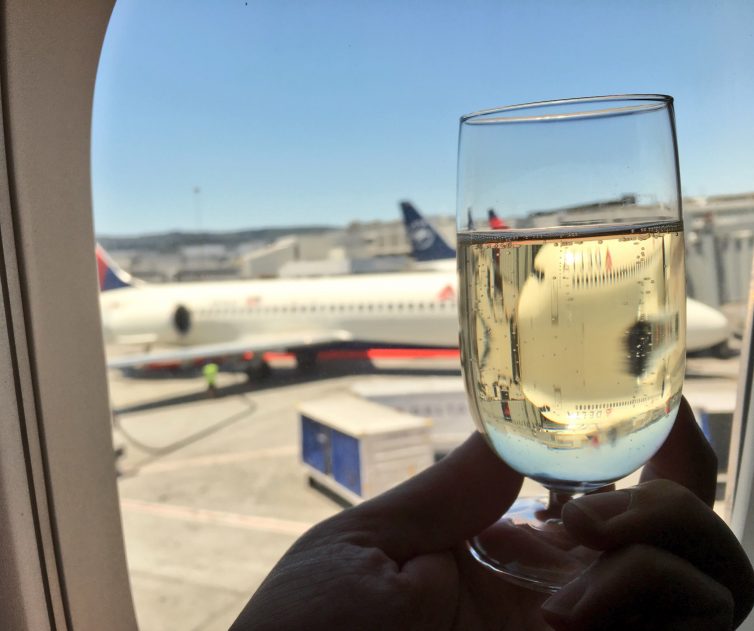
When life gives you lemons, make champagne – Photo: Jason Rabinowitz
Delta Air Lines likes to call itself the ’œthe on-time machine.’ Heck, they even filed for trademark protection of that term. Indeed, the airline does have a statistically high on-time performance and completion factor. But what happens when your flight is one of the minority that does get delayed? And what if I actually wanted it to be delayed? Weird, right?
Recently, I had to fly from San Jose (SJC) to New York City. San Jose is one of those oddball cities where the flights back to New York are lacking; just one non-stop exists, and it’s a redeye, which I won’t do. This meant I could get a little creative while booking. I settled on a one-hop journey through Salt Lake City, which would be my first visit to Utah.
During the booking process, the Delta website prompted me several times to upgrade to First Class. For $120, I would be upgraded on both legs of the trip, which isn’t such a bad deal considering I have paid nearly that much for Comfort+ domestically. I took the bait and selected my new seats, expecting to fly on a beat up ex-Northwest Airbus A319 and one of the older Boeing 737-800s with seatback entertainment screens.
The morning of my flight, I was minding my own business, watching TV in my hotel room when I suddenly got an email, text message, and app alert from Delta. Here we go, it’s the delay notification carpet bomb. My flight from San Jose to Salt Lake City was suddenly delayed three hours, meaning I wouldn’t have a chance at making the connecting flight (the last of the day) to New York. It was time to get creative if I wanted to get home.

Air India’s Dreamliner livery – Photo: Manu Venkat | AirlineReporter
Let’s start with the bare facts: India’s flag carrier Air India doesn’t have a great reputation. Whenever I’ve asked people about their experience on the airline, they cite inexplicable delays, poorly maintained aircraft, a non-negligible risk of food poisoning, or rude staff. Or, sometimes, all of the above. As a friend of mine put it, ’œIf my only choice for a flight was Air India, I would just skip the trip and stay at home.’
As an American of Indian descent, I’ve always been a bit disappointed that my ancestral homeland’s flag carrier apparently doesn’t seem to have its act together. As someone who has never flown with the “maharaja,” part of me also wondered whether the airline is actually better than the reputation suggests. I decided to find out for myself.
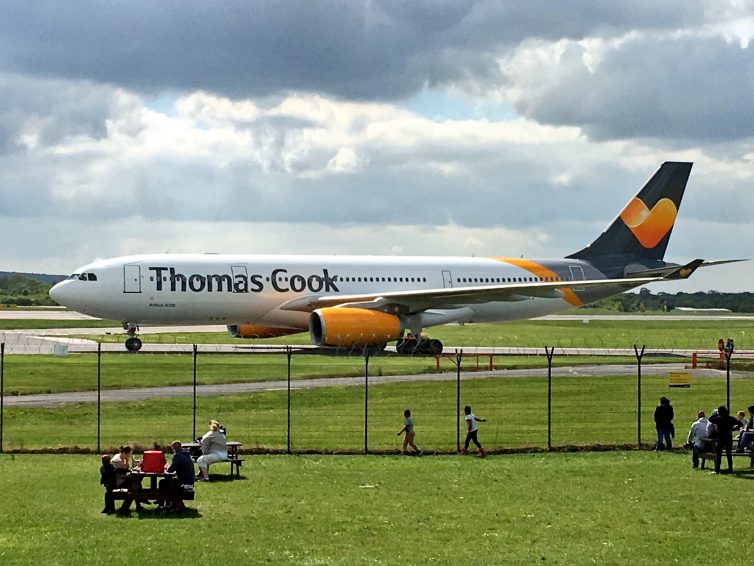
A Thomas Cook Airbus A330 taxis by the Manchester Airport Runway Visitor Park – Photo: Jason Rabinowitz
Every few days, I tweet out another installment of my ’œairline you’ve (probably) never heard of before’ series. For many of you reading this, Thomas Cook Airlines probably fits that description. Thomas Cook is not a new airline, or really even that small. But unless you are European and going on holiday, you probably have not come across Thomas Cook as an option before.
That is slowly changing, as Thomas Cook starts its transformation from a primarily holiday booking and charter operation to full-time scheduled airline alongside its sister airline Condor. This is a daunting challenge, nearly as difficult as starting up a new airline from scratch in some regards. The airline reached out to me to give me a look at how they are changing, and offered a review flight in its Premium Class product. My response to them, basically, was ’œyou have a premium class product?’ It does, and it is worth a closer look.
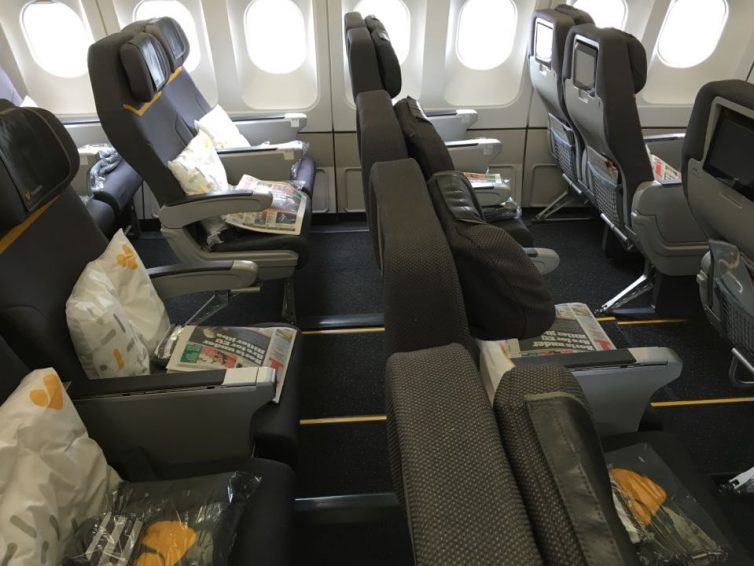
The Premium Class cabin on my Thomas Cook A330 – Photo: Jason Rabinowitz
Before I continue, it’s important to convey that Thomas Cook is not competing with other airlines on a basis of lie-flat seats or posh lounges. What it brings to the table is a specific value proposition. Getting passengers from A to B in relative comfort for the lowest fare possible. The airline is often hundreds of dollars less than its competitors flying between New York and Manchester — the route that I flew.
I wouldn’t blame you if you were to say ’œsave hundreds of dollars? The flight is probably crap, right?’ It isn’t. In fact, flying between New York and Manchester, it’s one of the better options. The Thomas Cook intercontinental fleet operates using the Airbus A330, and each aircraft has recently been refurbished. Each A330 sports economy in a 2-4-2 configuration, not the squishy 3-3-3 you might have found in the past. Each seat has its own on-demand entertainment screen, complete with USB port to charge your own device. You won’t find either of those things on a certain U.S.-based airline also operating this route.
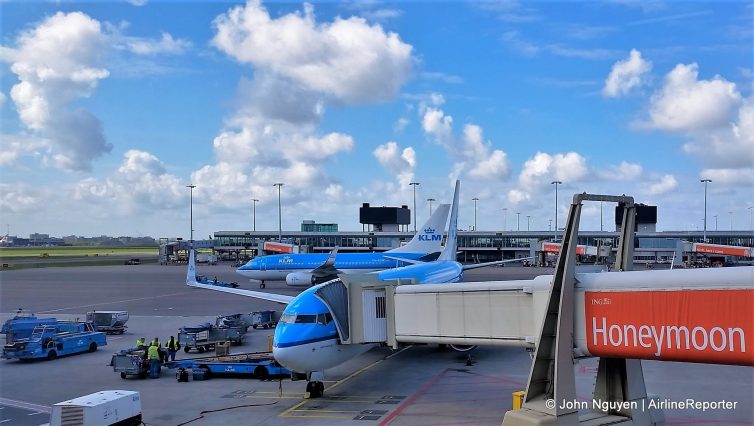
KLM 737-900 (PH-BXT) at Amsterdam Airport Schiphol, ready to take us to Prague, with a 737-700 (PH-BGW) taxiing behind
Koninklijke Luchtvaart Maatschappij is not exactly a household name in most of the world, but its initials “KLM” and sky blue branding and livery are easily recognizable. I had a quick visit to Amsterdam before moving on to Prague this past spring, so flying on the national carrier of The Netherlands out of its homebase was the most obvious choice.
As I’ve pointed out numerous times, the European concept of business class (some better service, but the same seat as in economy, just with the middle seat blocked) is never worth it on personal trips, especially for a short flight blocked for 90 minutes gate-to-gate. Addtionally, flying KLM (being a member of SkyTeam) meant flying outside my alliance, so no priority anything nor lounge access.
What could possibly go wrong?!
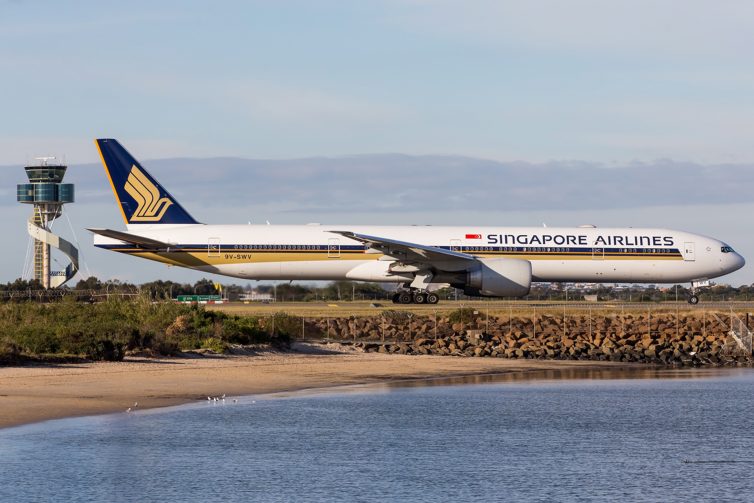
A Singapore Airlines Boeing 777-300ER taxis for departure at Sydney – Photo: Rory Delaney
It has been over eight years since my last Singapore Airlines (SQ) flight. I have always had a great fondness for SQ; after all, it was the first airline I traveled on internationally when I was just four years old, going from Australia to Europe. Even when I flew them eight years ago, they were still in my opinion the carrier to beat in economy class. With much excitement and anticipation, I booked my next series of flights with Singapore Airlines, as they turned out to be the cheapest and most convenient option for a recent work trip to Southeast Asia. I was curious to see if they were still able to deliver a class-leading product in economy class, even with the ever increasing threat of competition from the three large Middle Eastern carriers.
I ended up taking four flights for my trip, but I will focus on the first flight I took from Munich to Singapore. This flight left the strongest impression on me, and the fact that there were only about 80 passengers in economy class made for a very comfortable flight.





